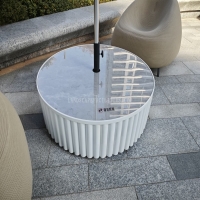Welcome to the website for landscape facilities products and knowledge.
How does the table’s design ensure it can be easily cleaned with minimal water or chemical use?
Modern table design strategically integrates multiple features to drastically reduce cleaning resource requirements. The surface treatment employs advanced hydrophobic nanotechnology, creating an invisible barrier that causes liquids to bead up and roll off rather than soaking in. This fundamental characteristic means most daily spills can be wiped away with a barely damp cloth, eliminating the need for excessive water or harsh cleaning agents.
Manufacturers now utilize non-porous composite materials that resist staining at a molecular level. Unlike traditional wood or porous surfaces that absorb liquids and require aggressive scrubbing, these engineered materials prevent penetration entirely. The seamless construction with rounded corners eliminates dirt-trapping crevices where grime typically accumulates, further simplifying maintenance.
Many contemporary tables incorporate photocatalytic coatings that activate under ambient light, continuously breaking down organic matter through oxidation. This self-cleaning technology reduces the frequency of manual cleaning interventions. Additionally, the strategic use of antimicrobial additives in the material composition inhibits microbial growth without requiring chemical disinfectants.
Edge design has evolved to include integrated drainage channels that direct spills toward contained collection points, preventing liquid spread across the surface. This containment system allows for targeted cleaning rather than entire surface treatment. The overall elevation of cleaning efficiency represents a significant advancement in sustainable furniture design, addressing both environmental concerns and practical maintenance challenges through intelligent engineering solutions.
Related search:

Recommendation
Round metal tube border design table with tempered glass or granite countertop on the top.